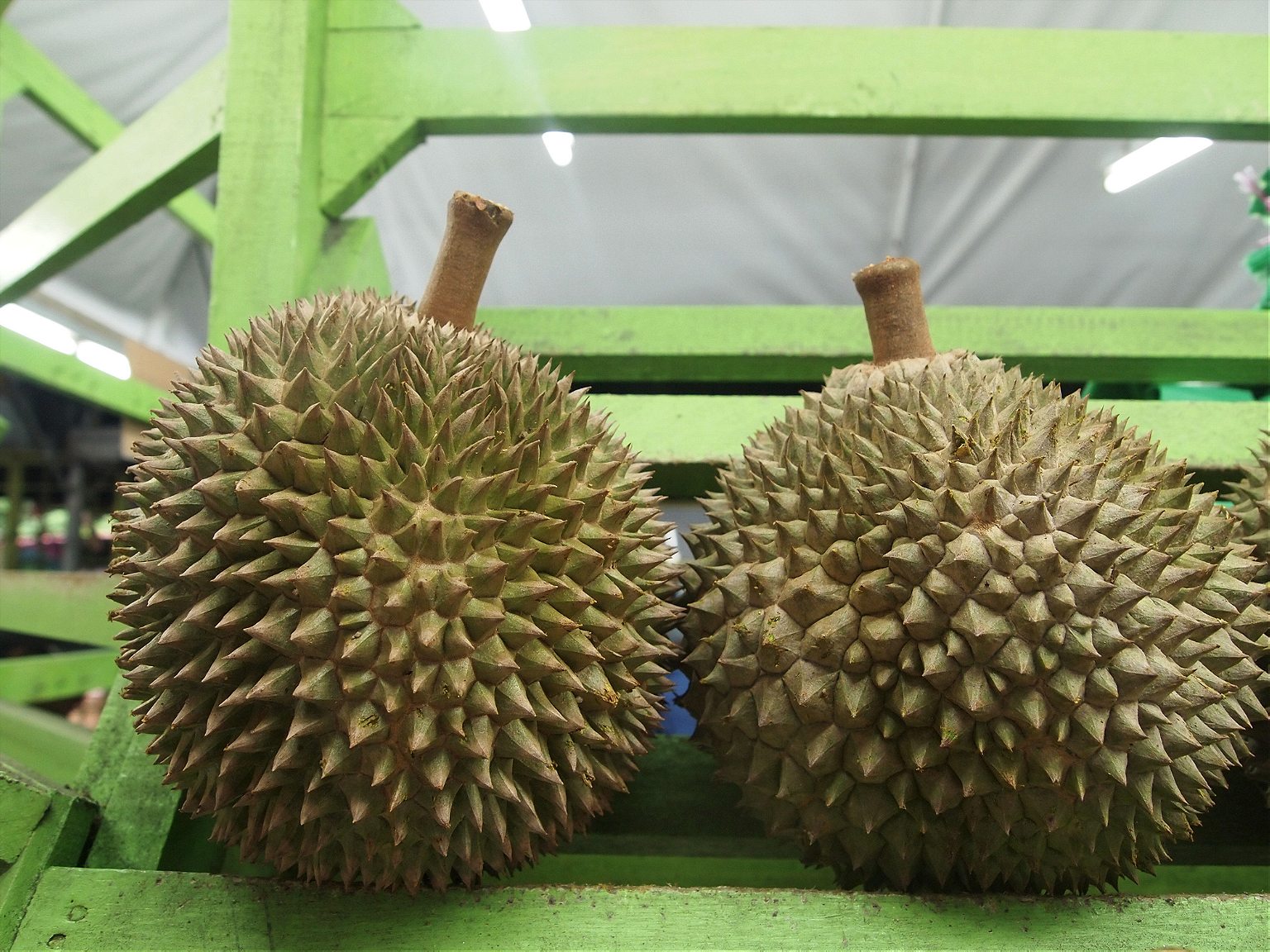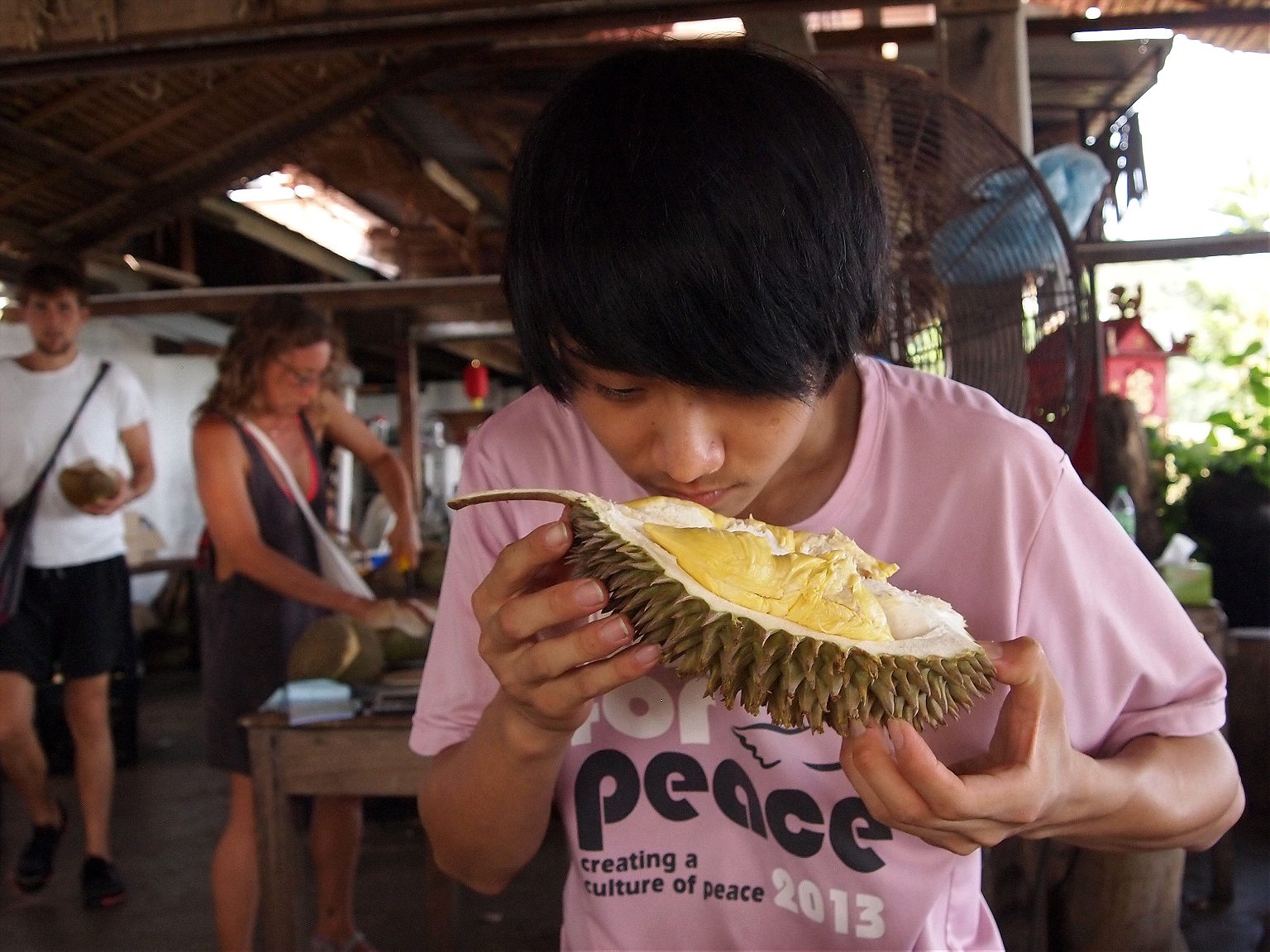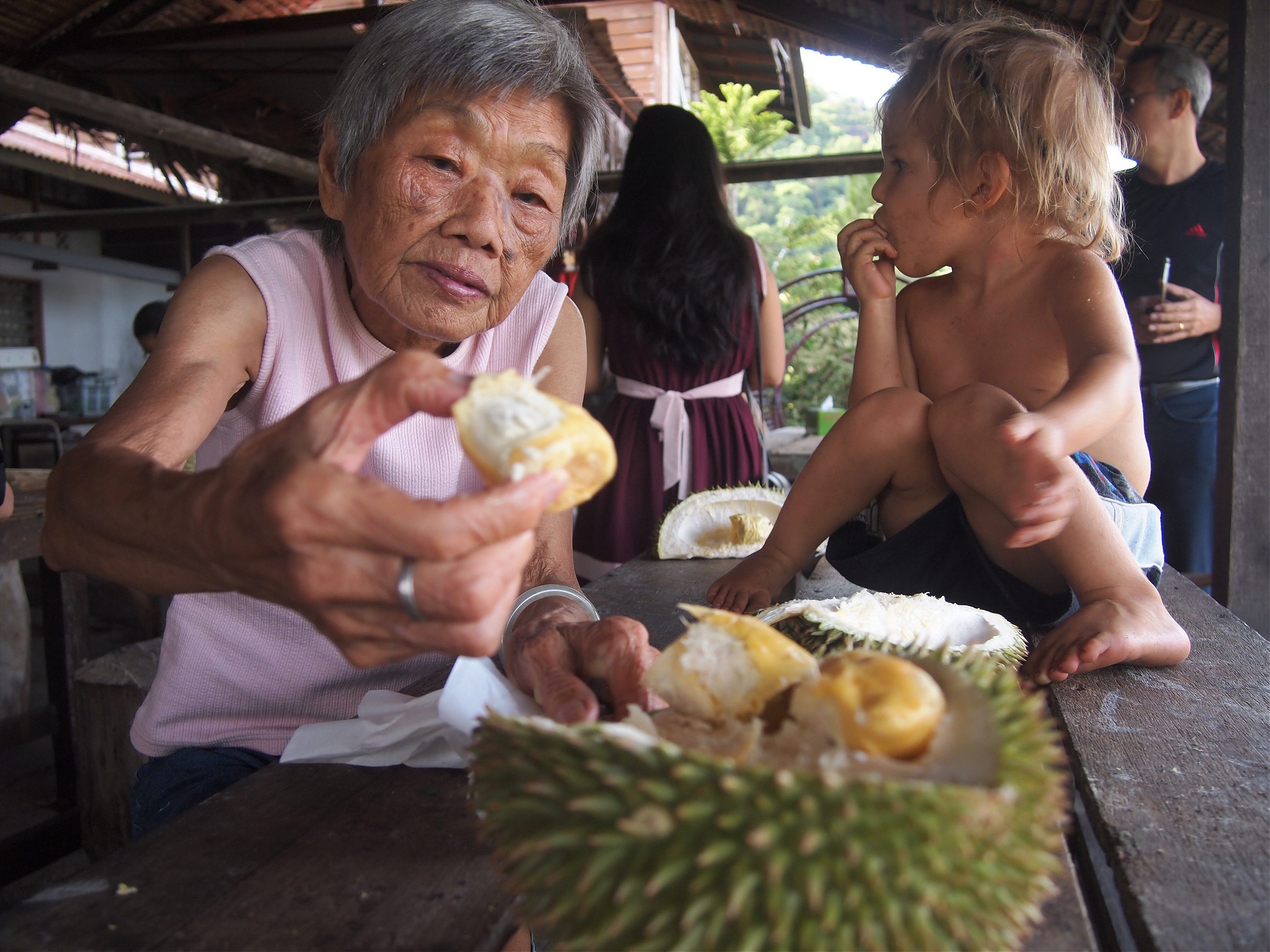Trekking around the world in pursuit of the famously odoriferous fruit.
By the middle of the afternoon, my fingers are crisscrossed with tiny nicks and cuts as if I’ve been playing with irritated cats for six hours instead of serving fruit.
I set a durian on the rough, slatted table where my assigned group sits: two couples from Hong Kong who are visiting Penang, Malaysia specifically to indulge in durian. The men wear polo shirts already stained around the armpits with sweat. One woman fans herself with a floppy white-and-black sunhat, gazing at the view over the treetops, where the farm plunges steeply toward the heat-hazy Straits of Malacca far below.
Penang is a well-known destination for durian lovers, who flood the island each June and July for the short but sweet season when the large, thorn-encrusted fruits tumble from trees into nets suspended over roads and walkways. Buses filled with Chinese tourists trundle up the winding switchbacks of the mountainous west coast to deliver their passengers to farms and roadside establishments specializing in durian. These places have tables lined with napkins and water bottles, a sink to wash your hands, and, ideally, a good view. When you sit down, a host, called the durian tukang, takes your order. High-end locales offer flights of durian, in the same manner that vineyards offer flights of wine.

Bao Sheng’s Durian Farm is among the oldest and most popular durian spots on the island. Each day a tour bus parks precariously on the narrow road above the farm, while cars and taxis jostle around each other in the slanted drive. The season reaches a fevered pitch in late June, when Bao Sheng’s signature durian comes into season: Red Prawn. The farsighted Chang family, which has owned the farm for four generations, planted the trees back in 1959, and fifty years later the variety has a richness and daintiness in texture that is, in my experience, unmatched.
Perhaps foretelling its success, the farm’s name translates loosely as abundance, or, in the words of Mr. Teik Seng Chang, the farm’s current owner, “it means the tree grows very well.” Four years ago, when I first visited Bao Sheng’s, it wasn’t quite so crowded. There were few Westerners, and we stood out from his normal customer base. Mr. Chang took the time to sit with my group and open our durians, lovingly sharing his wisdom on how to select, open, and enjoy the mythically spiny fruits. We were spellbound.
“Your people,” Mr. Chang commented to me years later, referring to Westerners, “are not so full of durian already. So you can learn.”
My third summer at Bao Sheng’s, I began serving durian. Some guests come to Bao Sheng’s to learn the subtleties of tasting durian, but many come just to eat; I can’t tell yet what the two couples in my group want.
“At Bao Sheng’s,” I tell the group, “We serve durians in a sequence, beginning with sweet, fruity-tasting durians and finishing with durians that taste like coffee, chocolate, or wine.” I pat the durian’s thick thorns with the flat of my open pocketknife. “We are starting with a variety called 604 because it is sweet and has a light, flowery aroma.”

By now I have their full attention. I tilt the durian and plunge the thin blade into its bottom all the way to the hilt. With a quick twist it pops open easily, unzipping itself along the seams of its thorny shell; 604’s have unusually thin shells and I have a lot of practice. As I arrange the creamy flesh for them to taste, they pepper me with questions I’ve come to expect. A Caucasian woman serving durian to Asians is a perplexing role reversal to many guests.
“How did you learn about durians?” the man asks.
“Sorry, it’s just that we never knew that Westerners can like durian,” his wife says. “It’s quite unusual.”
“And you can stand the smell?” the other woman asks, “I imagine it must be quite smelly for you to work here.”
The durian is so strongly perfumed it’s banned on public transit throughout Southeast Asia. Scientists have attempted to dissect its aroma for decades, as in a 2012 study by the Journal of Agriculture and Food Chemistry. However, the fruit never smelled bad to me. I first smelled it at an American music festival, where an odd, unidentifiable scent lingered on the breeze: not quite body odor, not quite marijuana or cooking smoke, but definitely not disgusting, like sewage or natural gas or—as Anthony Bourdain once described it—like kissing your dead grandmother. It simply smelled exotic, in the most alien definition of the word.

The hippies around me said the smell was durian. They explained it with a passionate religiosity on par with their other plant medicines. “It’s like nirvana in a fruit,” one enthused. Another said it was prehistoric proof of the symbiosis between Mother Earth and humans. They swore durian gave them a buzz similar to marijuana. Soon after, I met a man who claimed to be addicted to durian. He hadn’t gone a day without eating it in over seven years.
It was all too bizarre not to investigate, so as soon as I got home I purchased a frozen durian at the small Chinese grocery near my house. Half-frozen, it reminded me of vanilla ice cream dusted in chives. It was tasty, but not so tasty I’d travel across the world to eat it (yet; that was coming soon). What hooked me were the stories.
I didn’t think anything could top the hippies’ psychedelic yarns, but over the next year I began collecting strange, ridiculous, wonderful stories about durian. The global worth of the durian industry has never been calculated, but huge domestic and international demand, especially from China, contributes to a mania that beggars belief.
In 2005, a Mandala Air jet crashed purportedly because someone smuggled three unaccounted-for tons of durian into the hold. In Singapore a quarrel over durian ended in a stabbing, while another in Malaysia ended with a murder charge. A man in Thailand died inexplicably after consuming four five-pounders by himself, while another died after washing his durian down with milk, and yet another with beer. I read about $700 U.S. durians that can only be purchased by those with royal connections, and ancient warriors who battled tigers over the fruits.
Eventually, I began hearing rumors about a “durian trail,” which refers to the fact that not all durian trees across Southeast Asia ripen at the same time. They’re staggered due to the circular movement of the monsoonal rains as they sweep across the region. When, with a little research, I realized it would be possible to stay in peak durian season 365 days of the year by hopping from country to country, my husband suggested we actually fly halfway across the world and follow it. We wanted to travel Southeast Asia anyway, and tracking a weird, stinky fruit seemed like a good way to have some adventures. As a joke, we called our trip the Year of the Durian and started a blog. Why not add our own over-the-top story to the durian anthology?
I dug my fingers around the slippery seeds with gusto
Initially, we didn’t take the project too seriously. We were like all backpacking youths slumming their way across various nations, but in place of a battered Lonely Planet I had a notebook filled with people and places related to durian. Planning the trip was difficult, so we took it step by step, following clues I found in blogs and online news articles. We began in Sumatra, where the first Westerner to write home about durian landed around 1420. From there, we traveled onwards through Indonesia, to Thailand, Cambodia, and Vietnam, then south to Malaysia and Singapore, took a hop to the Philippines and Sri Lanka, and gave ourselves a grand durian finale with the wild fruits of Borneo.
By the time we arrived at Bao Sheng’s in Penang, my durian fixation was no longer a casual and amusing curiosity. I was genuinely hooked.
I worried in the beginning I would tire of tasting durians. But the more durians we ate, the more I noticed the different types and flavors endemic to each location. In Thailand, the durians were pale to deep yellow, fibrous, and pasty as marzipan. In the Philippines they were white and soupy like yogurt. In Penang, the variation was broader, with durians that were salmon orange and fluffy as whipping cream, deep gold and sticky as peanut butter, or pale white with an alcoholic rum punch.
Our first night on the durian trail, we went to Ucok’s Durian Stall in Medan, Sumatra. The tukang durian set a bright, yellow-fleshed durian in front of us. “That one will be sweet,” the woman next to me explained. She said the tukang durian can tell whether a durian will be sweet like frosting or bitter like chocolate or coffee just by sniffing the exterior of the fruit. “Choosing durian is an art,” she said. “It takes a lot of practice, and a good nose.”
We were sitting elbow-to-elbow along long rows of tables under brilliant white lights; a family of women in black hijabs on one side and the Chinese couple on the other. I dug my fingers around the slippery seeds with gusto while our neighbors watched, amused.

“You are really brave,” the husband said over the lawnmower drone of motorbikes in the street. “I saw that show about the bizarre foods,” he said, referencing Andrew Zimmern’s television series. “He can eat all those live snakes and all this disgusting stuff, but he can’t eat durian. Durian is so scary for Western peoples.”
Surprise followed us to every durian stall. Locals were convinced that, because of our Western heritage, we should be repulsed by the durian’s odd, sweet-garlic-and-gas aroma. It was as if durian aversion was a European genetic trait, despite the fact that seemingly every Asian family includes someone who finds durian as noxious as Zimmern.
Like cilantro aversion, which has only a minor genetic component, disliking durian is most likely largely a matter of personal preference and cultural expectations, although the exact reasons that some people love it while others revile it are not entirely clear. In A Stinky King: A Cultural and Social History of the Durian, Andrea Montanari points out that early European explorers were more often delighted than repulsed by their first durian discovery. The 16th century Portuguese explorers Tomé Pires and Garcia de Orta both crowned durian the best fruit in the world.
Montanari theorizes that European chilly feelings toward durian developed with colonialism and Victorian prudishness. Around this time, even overly juicy oranges were considered too carnal for the dinner table (well-bred ladies retired to their private rooms to peel and eat them) and the smelly, messy durian was offensiveness incarnate.

The durian season created what European colonizers saw as chaos. Laborers defected to the jungles to search for fallen fruits and discarded durian shells piled so high in the streets that they became a nuisance, popping early automobile tires; the overpowering odor was inescapable. Durian was an uncontrollable force, the antithesis to the order colonizers hoped to impose on the tropics.
I tell all this to the group as I line up three more durians for them to taste. My unexpected presence has incited their curiosity, and whether or not they originally came for a lesson in durian, they’re getting one now.
I tease them that soon, they may have to compete with Westerners for the coveted fruit. Maybe durian will become as hip as sushi. They laugh, but I’m only half-joking. I see more and more Westerners at Bao Sheng’s every year. The competition may in part be my fault. The silly blog we started has attracted durian lovers from all over the world, and now has over 1.5 million page views. I’ve started organizing durian tours and events, and in a week, 60 Western durian lovers will descend on Bao Sheng’s for a weeklong feast.
I shake the durians and smell them, rotating each durian under my nose as I inhale slowly. I’m searching for the tingly, spicy aroma that would denote a special taste, the one I want to stay on their tongues as they trundle back down the mountain into motorcycle chaos of the city. It’s an odor like no other I’ve ever experienced, one that smells cold and smoky like a campfire on a misty morning. When it hits my nose I feel a rush of pleasure. Those hippies were right about one thing: durian certainly is addictive.